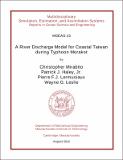A River Discharge Model for Coastal Taiwan during Typhoon Morakot
Author(s)
Mirabito, Christopher; Haley, Jr; Patrick J., Lermusiaux; Pierre F., Leslie; Wayne G.
DownloadADA568372.pdf (2.129Mb)
Open Access Policy
Open Access Policy
Creative Commons Attribution-Noncommercial-Share Alike
Terms of use
Metadata
Show full item recordAbstract
In the coastal waters of Taiwan, freshwater discharge from rivers can be an important source of uncertainty in regional ocean simulations. This e ect becomes especially acute during extreme storm events such
as typhoons. In particular, record-breaking discharge caused by Typhoon Morakot (August 6{10 2009) was
observed to signi cantly a ect near-shore temperature and salinity during the Intensive Ob- servation
Period-09 (IOP09) of the Quantifying, Predicting and Exploiting Uncertainty (QPE) research initiative. In
this report, a river discharge model is developed to account for the sudden large in ux of freshwater during
and after the typhoon. The discharge model is then evaluated by comparison with the discharge time series
for the Zhu oshu (?4) and G aop ng (?O) Rivers and by its utilization as forcing in ocean simulations. The
parameters of the discharge and river forcing models and their e ects on ocean simulations are discussed.
The reanalysis ocean simulations with river forcing are shown to capture several of the independently
observed features in the evolution of the coastal salinity eld as well as the magnitude of the freshening of
the ocean caused by runoff from Typhoon Morakot.
Date issued
2012-08-01Department
Massachusetts Institute of Technology. Department of Mechanical EngineeringPublisher
Defense Technical Information Center
Citation
Mirabito, Christopher, Haley, Jr, Patrick J., Lermusiaux, Pierre F., Leslie and Wayne G. 2012. "A River Discharge Model for Coastal Taiwan during Typhoon Morakot."
Version: Original manuscript